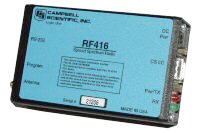RF416 2.4-GHz Spread-Spectrum Radio
The RF416 spread spectrum transceiver has an operating frequency range of 2.45 to 2.46 GHz, which is used in many countries world-wide. The RF416 is a compact, rugged, low-cost transceiver intended for use in a variety of applications.
The transceiver transmits at a power level of 60 mW and frequency-hops among 25 channels to avoid interference with other devices. This improves performance in environments where RF noise, pagers, and cellular phones could potentially reduce communication between devices. The RF416 may be used without an individual FCC license.

Features
Replaces the RF415 spread-spectrum radio.
Rugged, low-cost transceivers
60 mW, 2.45- to 2.46-GHz frequency
Frequency-hops over 25 channels.
Does not require an individual FCC license.
Can be used in the field as a transceiver or in the office as the base station.
Current drain can be as low as 1 mA (stand by).
Transmits up to one mile with omnidirectional antenna; up to ten miles with higher gain directional antennas.
Settings are stored in non-volatile memory.
Specifications
Operating Frequency: 2.450 to 2.460 GHz
Type: Frequency Hopping Spread Spectrum (FHSS) Transceiver
I/O Data Rate: 38.4 K, 19.2 K, 9600, 4800, or 1200 bps
Channel Capacity: 65,000 Network Identifiers share 25 hop channels
Frequency Hopping Patterns: Six different selectable patterns
Receiver Sensitivity: -104 dBm at 10-4 bit error rate (Campbell Scientific protocols will issue retries wherever a bit error occurs)
Interference Rejection: 70 dB at pager and cellular phone frequencies
Transmitter Power Output: 50 mW nominal
Antenna Connector: Reverse polarity SMA
FCC ID: OUR-24XSTREAM
Power: 9 to 16 Vdc
Average Current Drain
Stand-by: <1 mA (power-saving options used)
Receiving: 36 mA
Transmitting: 75 mA
LEDs: Power on, TX, RX, diagnostics
RS-232 Connector: 9-pin “D” Female (4 wire: Tx, Rx, CTS, GND)
CS I/O Connector: 9-pin “D” Male (newer dataloggers provide power to the radio on this connector. Dataloggers purchased before December 1997 require the #14291 Field Power Cable.)
Power Connector: Barrel plug, center positive 12 V; used to connect the 14291 Field Power Cable
RF432 2.4-GHz Spread-Spectrum Radio
The RF430, RF431, and RF432 radio modems are functionally the same as the RF401, RF411, and RF416 models, except for a change to their ports. The RF430-series radios have a USB port instead of the CS I/O port that the RF401-series radios have. The USB port makes it easier to connect to newer computers, and the RS-232 port still allows them to be connected to our current dataloggers. Networks can include a mix of the RF430-series and RF401-series radios.
The RF432 spread-spectrum transceiver has an operating frequency range of 2.45 to 2.46 GHz, which is used in many countries worldwide. The RF432 is a compact, rugged, low-cost transceiver intended for use in a variety of applications.
The transceiver transmits at a power level of 60 mW and frequency-hops among 25 channels to avoid interference with other devices. This improves performance in environments where RF noise, pagers, and cellular phones could potentially reduce communication between devices. The RF432 may be used without an individual FCC license.

Features
Equivalent to RF416, but with USB port instead of CS I/O port
Rugged, low-cost transceivers
60 mW, 2.45- to 2.46-GHz frequency
Frequency-hops over 25 channels.
Does not require an individual FCC license.
Can be used in the field as a transceiver or in the office as the base station.
Current drain can be as low as 1 mA (stand by).
Transmits up to one mile with omnidirectional antenna; up to ten miles with higher gain directional antennas.
Settings are stored in nonvolatile memory.
Specifications
Operating Frequency: 2.450 to 2.460 GHz
Type: Frequency Hopping Spread Spectrum (FHSS) Transceiver
I/O Data Rate: 38.4 K, 19.2 K, 9600, 4800, or 1200 bps
Channel Capacity: 65,000 Network Identifiers share 25 hop channels
Frequency Hopping Patterns: Six different selectable patterns
Receiver Sensitivity: -104 dBm at 10-4 bit error rate (Campbell Scientific protocols will issue retries wherever a bit error occurs)
Interference Rejection: 70 dB at pager and cellular phone frequencies
Transmitter Power Output: 50 mW nominal
Antenna Connector: Reverse polarity SMA
FCC ID: OUR-24XSTREAM
Power: 9 to 16 Vdc
Average Current Drain
Stand-by: <1 mA (power-saving options used)
Receiving: 40 mA
Transmitting: 78 mA
LEDs: Power on, TX, RX, diagnostics
RS-232 Connector: 9-pin “D” Female (4 wire: Tx, Rx, CTS, GND)
Power Connector: Barrel plug, center positive 12 V; used to connect the 14291 Field Power Cable
Producing Area:USA